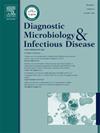Genotyping and antimicrobial resistance profile of ESKAPE pathogens from a tertiary care hospital in Jammu & Kashmir, India
IF 2.1
4区 医学
Q3 INFECTIOUS DISEASES
Diagnostic microbiology and infectious disease
Pub Date : 2025-01-25
DOI:10.1016/j.diagmicrobio.2025.116714
引用次数: 0
Abstract
The rise of MDR (multi drug resistant) ESKAPE pathogens in hospitals is a pressing global healthcare crisis, demanding urgent attention and action. The current study investigates the prevalence and antimicrobial resistance patterns of ESKAPE pathogens in a tertiary care hospital in the union territory of Jammu and Kashmir, India. Out of 244 ESKAPE pathogens isolated in present study from patients of a tertiary care hospital, 84 (34.4 %) isolates were identified as Staphylococcus aureus, of which 59.52 % were identified as methicillin resistant S. aureus (MRSA), 4.76 % were methicillin sensitive S. aureus (MSSA) and 35.71 % were methicillin resistant coagulase negative staphylococci (MR-CoNS). The mecA gene (methicillin resistant staphylococcal cassette chromosome) was detected in 61.9 % of the S. aureus isolates of the present study. Klebsiella pneumoniae was the second most prevalent (28.75 %) pathogen, followed by Pseudomonas aeruginosa and Escherichia coli (27.5 % each), Acinetobacter baumannii (11.87 %), and others. A higher number of isolates were recovered from male patients (61 %) than from female patients (39 %). Screening for β-lactamase genes (blaTEM, blaSHV, blaCTX-M-15) revealed that 32.5 % of isolates carried the TEM gene (Temoniera), 36.87 % had the CTX-M-15 gene (CefoTaXimase-Munich), and 20.62 % harboured SHV variants (Sulfhydryl Variable). Notably, 23 isolates, predominantly K. pneumoniae, were positive for all three β-lactamase genes, highlighting the significant prevalence of multidrug resistance among ESKAPE pathogens in the region. This study provides epidemiological data on the prevalence of ESKAPE isolates in tertiary care hospital in the union territory of Jammu and Kashmir, India. To our knowledge, this is the first comprehensive report on the prevalence of ESBL genes in ESKAPE pathogens of this region. Further, this study underscores the critical need for enhanced surveillance and targeted antimicrobial stewardship programs to address the growing challenge of antimicrobial resistance in hospital settings.
求助全文
约1分钟内获得全文
求助全文
来源期刊
CiteScore
5.30
自引率
3.40%
发文量
149
审稿时长
56 days
期刊介绍:
Diagnostic Microbiology and Infectious Disease keeps you informed of the latest developments in clinical microbiology and the diagnosis and treatment of infectious diseases. Packed with rigorously peer-reviewed articles and studies in bacteriology, immunology, immunoserology, infectious diseases, mycology, parasitology, and virology, the journal examines new procedures, unusual cases, controversial issues, and important new literature. Diagnostic Microbiology and Infectious Disease distinguished independent editorial board, consisting of experts from many medical specialties, ensures you extensive and authoritative coverage.

 求助内容:
求助内容: 应助结果提醒方式:
应助结果提醒方式:


